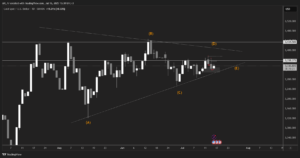Gold prices were mixed during trading today, Wednesday, after recording their biggest drop in a month in the previous session, as high U.S. inflation raised concerns that the Federal Reserve may delay lowering interest rates until after June.
Gold fell 1.1% on Tuesday after data showed U.S. consumer prices rose sharply in February, beating expectations and suggesting some persistence in inflation. This was gold’s worst one-day decline since February 13, when data showed consumer prices also rose more than expected in January.
The U.S. Bureau of Labor Statistics reported that the Consumer Price Index rose 0.4% on a monthly basis and 3.2% on an annual basis in February. The monthly increase was in line with expectations, but the annual rate was above the 3.1% forecast.
More U.S. data is due ahead of the Fed’s meeting next week, with the Producer Price Index report due on Thursday and the preliminary reading of the University of Michigan’s consumer sentiment index and inflation expectations due on Friday.
The U.S. inflation reading pushed up U.S. Treasury yields and the dollar. The yield on the 10-year Treasury note got an extra boost after weak demand at a $39 billion auction of benchmark notes.
Gold and the Dollar Now
Gold futures are flat at $2166 an ounce. Spot gold is up 0.1% to $2160 an ounce. The dollar index is down about 0.03% to 102.517.
Other Metals
Platinum falls 0.1% in spot trading to $923.45 an ounce. Palladium falls 0.5% to $1036.44. Silver falls 0.3% to $24.08.
Bitcoin Breaks All Records, Targets This Level as New Peak
Bitcoin rose to a record high for the third time in five days before traders took the opportunity to take some profits off the table from recent gains.
The original cryptocurrency reached an all-time high of $73,650 in the past few minutes of trading on Tuesday before falling back below $70,000. The popular digital currency has hit new highs following a report from CoinShares showing $2.7 billion in inflows into cryptocurrency assets last week, with the bulk of that going into Bitcoin.
The success of Bitcoin exchange-traded funds (ETFs), which launched in the United States on January 11, is a major driver of the recent momentum. ETFs from the likes of BlackRock and Fidelity have attracted net inflows of about $10 billion so far.
In the UK, the London Stock Exchange (LON:LSEG) said it will accept applications for Bitcoin and Ether ETFs, while Thailand’s Securities and Exchange Commission said it will open up overseas cryptocurrency ETFs to retail investors.
Commerzbank: Fed May Wait Longer Before Cutting Rates
After recent statistics revealed the strength and persistence of U.S. inflation, analysts at Commerzbank believe the Federal Reserve can afford to wait longer before starting to cut interest rates.
In this regard, economists at the German investment bank explained that the path of inflation decline in the United States has stopped, as February data showed the Consumer Price Index rose 0.4% from the previous month, with services prices in particular rising, reflecting rising wage costs.
As a result, the rise in the inflation rate in January was not an extreme one or a reflection of data for just one month. Based on this, experts believe that the economic data suggests that markets are overstating their expectations of a potential rate cut by the Federal Reserve.
It is worth noting that the performance of the CME Group’s U.S. interest rate tracking shows a 99% probability that the Federal Reserve will keep rates on hold at its meeting next week.
For further insights, check OneRoyal’s Facebook, Instagram, and Twitter pages and expand your understanding of financial markets with global perspectives. Staying informed is crucial in the ever-evolving world of finance.
Disclaimer: This article is not investment advice or an investment recommendation and should not be considered as such. The information above is not an invitation to trade and it does not guarantee or predict future performance. The investor is solely responsible for the risk of their decisions. The analysis and commentary presented do not include any consideration of your personal investment objectives, financial circumstances, or needs.





